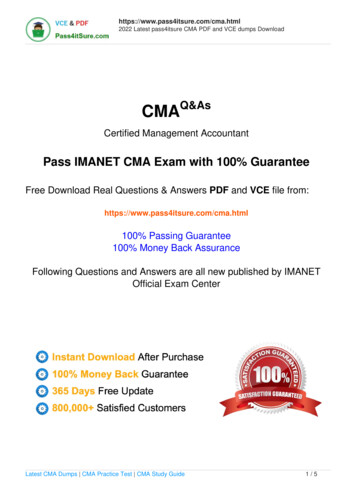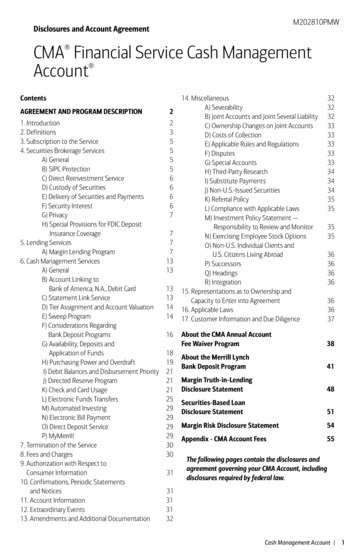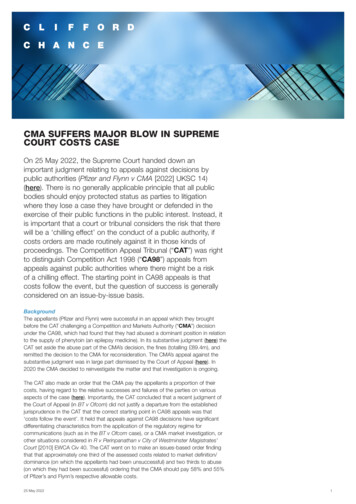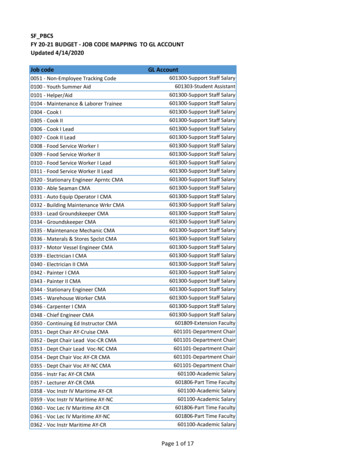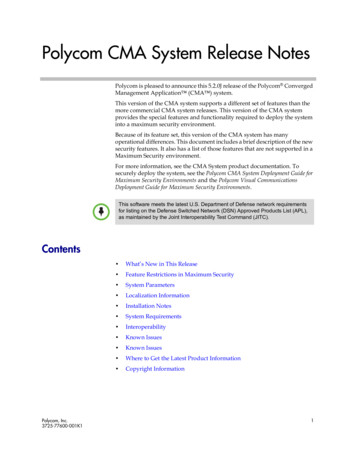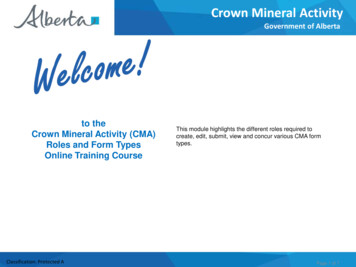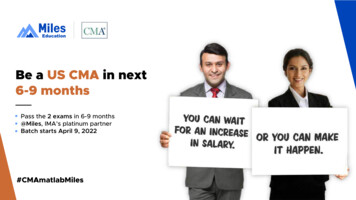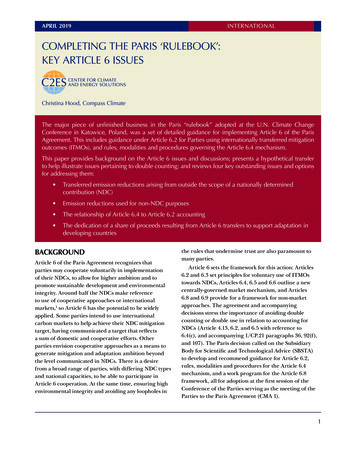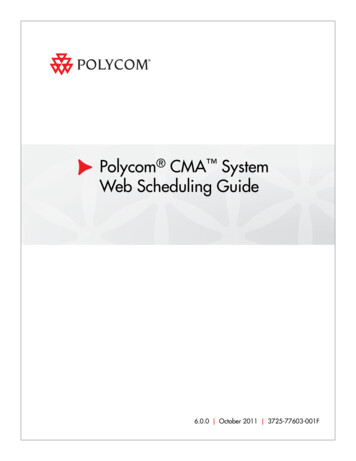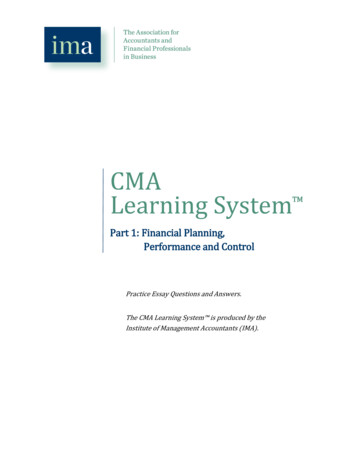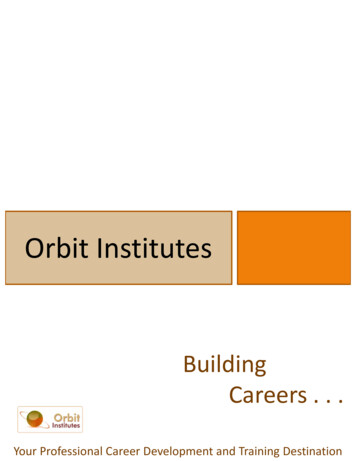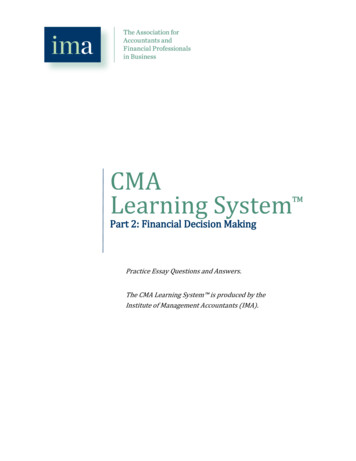
Transcription
CMALearning SystemTMPart 2: Financial Decision MakingPractice Essay Questions and Answers.The CMA Learning System is produced by theInstitute of Management Accountants (IMA).
copyright 2009 Institute of Management AccountantsThese materials are copyrighted and may not be reproduced in any form or used in any way tocreate derivative works. Any reproduction, reuse, or distribution of CMA Learning System materials without prior written permission from the Institute of Management Accountants (IMA) isillegal and a material violation of the IMA Statement of Ethical Professional Practice.Any Certified Management Accountant (CMA) or CMA candidate who reproduces, reuses, ordistributes CMA Learning System materials or content in any form without prior authorization fromIMA is subject to legal action and will be reported to the Institute of Certified ManagementAccountants (ICMA) and immediately expelled from the IMA and CMA program.It is your responsibility to ensure that any CMA exam review materials that you are using have beenprovided to you through authorized channels or personnel. If you are in doubt about theauthenticity of your materials or question the means by which they have been provided to you,contact IMA customer service at (800) 638-4427 in the U.S. or 1 (201) 573-9000.This material is designed for learning purposes and is distributed with the understanding that thepublisher and authors are not offering legal or professional services.CMALS Part 2: Financial Decision Making, Version 3.0 2009 Institute of Management Accountants. All rights reserved.2
Practice Essay QuestionsThe Institute of Management AccountantsCMA Learning System Part 2: Financial Decision MakingEssay QuestionsPractice Essay Questions (Section A to E) . 4Practice Essay Question Answers .27CMALS Part 2: Financial Decision Making, Version 3.0 2009 Institute of Management Accountants. All rights reserved.3
Practice Essay QuestionsPractice Essay QuestionsThe following essay questions, and the answers that appear at the end,were adapted from the Revised CMA exam, Questions and Answers:Part 4 (2005 and 2008) books supplied by the Institute of CertifiedManagement Accountants and are used with their permission.The focus of the questions will be on the test taker’s ability to applyconcepts presented in the part being tested to a business scenario.The answers supplied are meant to serve as samples of answers thataddress 80% or more of the points listed on the question grading guide.There are generally more points on the grading guide than points thatcan be awarded (i.e., there may be 110 possible points but only 100 thatcan be awarded in total), so answers scoring 80% may vary among testtakers. Thus, the answers presented here represent one possibleanswer, not a definitive correct answer.Part 2 Section A QuestionsQuestion 2A-ES01The accounting staff of CCB Enterprises has completed the preparation offinancial statements for the 2005 calendar year. The Statement of Income forthe current year and the Comparative Statement of Financial Position for 2005and 2004 are reproduced below.The accounting staff calculates selected financial ratios after the financialstatements are prepared. Average balance sheet account balances are used incomputing ratios involving income statement accounts. Ending balance sheetaccount balances are used in computing ratios involving only balance sheetitems. The ratios have not been calculated for 2005. Financial ratios that werecalculated for 2004 and their respective values are as follows. Times interest earned5.16 times Return on total assets12.5% Return on operating assets20.2% Return on common stockholders’ equity29.1%CMALS Part 2: Financial Decision Making, Version 3.0 2009 Institute of Management Accountants. All rights reserved.4
Practice Essay QuestionsCCB EnterprisesStatement of IncomeYear Ended December 31, 2005( 000 omitted)RevenueNet salesOtherTotal revenue 800,00060,000 860,000ExpensesCost of goods soldResearch and developmentSelling and administrativeInterest 540,00025,000155,00020,000Total expenses 740,000Income before income taxes120,000Income taxes (40% tax rate)Net income48,000 72,000CCB Enterprises Comparative Statement of Financial PositionDecember 31, 2005 and 2004( 000 omitted)20052004 26,000 21,000Receivables, less allowance for doubtful accounts( 1,100 in 2005 and 1,400 in 2004)48,00050,000Inventories, at lower of FIFO cost or market65,00062,000AssetsCurrent assetsCash and short-term investmentsPrepaid items and other current assetsTotal current assets5,0003,000 144,000 136,000 106,000 106,00010,0008,000 116,000 114,000 12,000 12,000Other assetsInvestments, at costDepositsTotal other assetsProperty, plant and equipmentLandBuildings and equipment, less accumulateddepreciation ( 126,000 in 2005 and 122,000 in 2004)Total property, plant and equipmentTotal assetsCMALS Part 2: Financial Decision Making, Version 3.0 2009 Institute of Management Accountants. All rights reserved.268,000248,000 280,000 260,000 540,000 510,0005
Practice Essay QuestionsLiabilities andStockholders’ EquityCurrent liabilitiesShort-term loans 22,000 24,000Accounts payable72,00071,000Salaries, wages, and other26,00027,000 120,000 122,000Total current liabilitiesLong-term debt160,000171,000 280,000 293,000 44,000 42,00064,00061,000 108,000 103,000152,000114,000Total stockholders’ equity 260,000 217,000Total liabilities and stockholders’ equity 540,000 510,000Total liabilitiesStockholders’ equityCommon stock, at parPaid-in capital in excess of parTotal paid-in capitalRetained earningsQuestionsA. Explain how the use of financial ratios can be advantageous to management.B. Calculate the following financial ratios for 2005 for CCB Enterprises (roundyour answer to three decimal places):1. times interest earned.2. return on total assets.3. return on operating assets.4. return on common stockholders’ equity.5. total debt ratio.6. total debt/equity ratio.7. current ratio.8. quick (acid test) ratio.CMALS Part 2: Financial Decision Making, Version 3.0 2009 Institute of Management Accountants. All rights reserved.6
Practice Essay QuestionsQuestion 2A-ES02Renbud Computer Services Co. (RCS) specializes in customized softwaredevelopment for the broadcast and telecommunications industries. Thecompany was started 30 years ago by three people to develop softwareprimarily for a national network to be used in broadcasting national electionresults. After sustained and manageable growth for many years, the companyhas grown very fast over the last three years, doubling in size. This growth hasplaced the company in a challenging financial position for the coming year.Within 30 days, RCS will need to renew its 300,000 loan, a current liability,with the Third State Bank of San Marcos. Harvey Renbud, president of RCS, isconcerned about renewing the loan because of the low amount of cash onhand. The bank has requested RCS's last year's income statement, comparativebalance sheets for the last two years, and six ratios relating to operatingperformance and liquidity.RCS Financial StatementsRenbud Computer Services Co.Income StatementLast YearNet revenues 2,500,000ExpensesCost of product services 1,500,000Selling and administration300,000Depreciation and amortization200,000InterestIncome taxes60,000150,000Total expenses 2,210,000Net income 290,000CMALS Part 2: Financial Decision Making, Version 3.0 2009 Institute of Management Accountants. All rights reserved.7
Practice Essay QuestionsRenbud Computer Services Co.Balance SheetPast Two YearsLast YearTwo Years AgoAssetsCash 50,000 50,000Accounts receivable, 00100,000Operating supplies and otherEquipment, netFurniture and fixtures, netOther long-term assetsTotal assets240,000200,00 1,930,000 1,560,000Liabilities and shareholders’ equityAccounts payable 150,000 130,000Taxes payable140,000120,000Note payable (Third State Bank)300,000200,000Bonds payable (due in 2002)400,000400,000990,000850,000Capital stock (1,000 shares)100,000100,000Retained earnings840,000610,000940,000710,000 1,930,000 1,560,000Total liabilitiesTotal shareholders’ equityTotal liabilities andshareholders’ equityQuestionsA. Explain why the Third State Bank of San Marcos would be interested inRenbudB. Computer Services Co.'s comparative financial statements, ratiocalculations, and industry ratios.Calculate the following financial ratios for Renbud Computer Services Co. Current ratios for the past two years. Accounts receivable turnover for last year. Total asset turnover for last year. Return on shareholders' equity for last year. Debt to equity ratio for the last two years.CMALS Part 2: Financial Decision Making, Version 3.0 2009 Institute of Management Accountants. All rights reserved.8
Practice Essay Questions Net income ratio (return on sales) for last year.C. Discuss briefly the limitations and difficulties that can be encountered inusing ratio analysis.Question 2A-ES03In the Statements of Financial Accounting Concepts, the Financial AccountingStandards Board (FASB) set forth the fundamentals on which financialaccounting and reporting standards are to be based. Specifically, the FASBintends that these concept statements establish objectives and concepts thatcan be used to develop standards for financial accounting and reporting, andto resolve new and emerging problems. Knowledge of the FASB objectives andconcepts should enable those affected by financial accounting standards tobetter understand the content and limitations of the information provided byfinancial accounting and reporting. Statement of Financial Accounting ConceptsNo. 1 discusses the objectives of financial reporting by business enterprises,and Statement of Financial Accounting Concepts No. 5 recommends thecomposition of a full set of financial statements.QuestionIdentify and describe the major sections of the Statement of Cash Flows.Section 2A: Question 2A-ES04Sentech Scientific Inc., a manufacturer of test instruments, is in contractnegotiationswith the labor union that represents its hourly manufacturing employees.Negotiations have reached an impasse, and it appears that a strike isimminent. The controller has called the general accounting manager into hisoffice to discuss liquidity issues if and when a strike does occur.The controller asks the accounting manager to recommend measures to assessliquidity if a strike were to occur. Although some of the nonunion employeescould probably produce test instruments during a strike, the controller wouldrather be conservative and assume no shipments during this time frame. Sincethe customers may go to other sources to obtain the products they needduring a strike, cash receipts for current outstanding amounts owed bycustomers may not be paid on a timely basis.QuestionsA. Define liquidity and explain its importance to Sentech.CMALS Part 2: Financial Decision Making, Version 3.0 2009 Institute of Management Accountants. All rights reserved.9
Practice Essay QuestionsB. Identify three measures that could be used to assess liquidity and explainhow to calculate these measures.C. Determine which liquidity measure identified above would best fit thecontroller’s requirements, and explain why. Include in your discussion thereasons why the other measures would not be as appropriate.CMALS Part 2: Financial Decision Making, Version 3.0 2009 Institute of Management Accountants. All rights reserved.10
Practice Essay QuestionsPart 2 Section B QuestionsQuestion 2B-ES01The Gershenfeld Foundation was established 25 years ago to encourage,promote, and support research in the physical sciences. A wide range ofindustrial corporations contribute money in support of the foundation’s work.The foundation has awarded research grants at a rate commensurate with itscontributions and portfolio earnings.Gershenfeld’s contributions have increased significantly the past few months.The results of the foundation’s recent fund drive exceeded the expectations ofthe Board of Trustees. New research grants are being reviewed and evaluated,but a final decision on which grants to fund and the amount of funding will notbe made for at least 60 days. Thus, Gershenfeld has an excess cash positionthat is expected to continue for two months.The Board of Trustees has instructed the foundation’s Executive Director toinvest the excess cash during this interim period. The Executive Director hasbeen instructed to earn the highest possible yield while maintainingmarketability and safety of principal. The types of investments that theExecutive Director is considering for the use of 3.5 million of excess cash are(1) certificates of deposit, (2) U.S. treasury bills, and (3) preferred stock ofdomestic corporations.QuestionsA. Define each of the following financial instrument characteristics and explainthe effect each has on the yield of investments.1. Default risk.2. Marketability.3. Maturity.B. Evaluate each type of investment being considered by Gershenfeld’sExecutive Director in terms of default risk, marketability, and maturity.C. Discuss the suitability of each type of investment being considered by theExecutive Director for Gershenfeld Foundation’s particular situation.CMALS Part 2: Financial Decision Making, Version 3.0 2009 Institute of Management Accountants. All rights reserved.11
Practice Essay QuestionsQuestion 2B-ES02Atrax Corporation is now a diversified company that was originally founded asa textile and milling company by Adam Traxal. During the 1980s and early1990s before any diversification, Atrax’s earnings had leveled off to about 2.25 per share. The growth possibilities in this industry were limited so thatthe demand for expansion funds has been low. There were large internal cashflows during this period, and Atrax regularly paid out 65% of its earnings ascash dividends. By the middle 1990s, this large dividend payout had become atrademark of Atrax’s common stock.The firm began diversifying into high-technology, growth companies in 1994in an effort to reduce its business risk from its dependence on a single sourceof sales. Traxal thought such diversification was essential to maintain Atrax’sfinancial health. The diversification program has been successful as far asTraxal is concerned. Atrax is no longer completely dependent on a singlesource of sales. The earnings have grown moderately to 2.80 per share since1994 despite the issuance of additional common shares. The price of the Atraxcommon stock has increased so that the P/E ratio is slightly higher than it wasin 1994. In addition, the 65% cash dividend payout ratio has been maintainedduring the expansion period.The diversification program at first was easily financed by the excess fundsthat were generated internally. Eventually though, the firm began to recognizethe need to use external sources—long-term debt and/or additional issues ofcommon stock—to finance its expansion programs. One consequence of theseveral common stock offerings was to dilute Traxal’s control over the firmbecause he was unable to purchase his pro rata share of the additionalofferings due to a shortage of personal funds. The Traxal family holdingsamounted to 54% of the firm’s stock in 1994 but their ownership has nowfallen to around 35%. However, Traxal is still able to maintain effective controlover the firm because no other stockholder owns more than 4% of the totalstock.Traxal believes that continued expansion is important for Atrax. Traxal isagainst any additional issues of common equity because he still cannotgenerate the personal funds necessary to purchase additional stock tomaintain his present equity position. However, further expansion could begreatly hampered if additional issues of common equity are not employed.Traxal has instructed his staff to suggest alternative proposals which wouldallow him to maintain control of Atrax and still continue the firm’sdiversification program. A summary of three proposals follow.Proposal 1The acquisition program would continue and be financed out of earnings notpaid out as dividends and from long-term debt issues and preferred stockissues. The current 65% cash dividend payout ratio would be maintained, andCMALS Part 2: Financial Decision Making, Version 3.0 2009 Institute of Management Accountants. All rights reserved.12
Practice Essay Questionsthere would be no additional issues of common stocks. However, there wouldbe an increase in long-term debt and preferred stock issues.Proposal 2The acquisition program would continue, and cash dividends would bereduced. The staff estimates that acquisitions could be financed withinternally generated funds and a minimum amount of long-term debt. Noadditional common equity would be required. Atrax could probably distributecash dividends equal to 10%-20% of earnings. This proposal would notsignificantly change Atrax’s present debt to equity relationship. In an attemptto appease stockholders who face a drop in their cash dividends, a stockdividend would be paid.Proposal 3The acquisition program would continue and be financed entirely byinternally generated funds by reducing the cash dividend payout rate to zero,if necessary. No additional long-term debt or shares of common stock wouldbe employed.QuestionsA. Adam Traxal finds Proposal 1 interesting but wonders what effect thiswould have on the rest of the firm and on the market value of AtraxCorporation’s common stock. Assuming that the price of a firm’s stock is theproduct of its current earnings per share and its historical price-earningsratio, indicate the ways in which implementing Proposal 1 would operate toaffect the market price of Atrax’s common stock.B. Adam Traxal considers Proposal 3 to be the least attractive because cashdividends might be reduced to zero. Explain what the probable short-term andlong-term effects would be on the market price of Atrax’s common stock if theacquisition program is dependent upon reducing the cash dividend payoutratio to zero.C. Adam Traxal considers Proposal 2 the most appealing because dividendswould still continue to be distributed.1. Would Traxal be able to maintain his current equity position of 35% if stockdividends were distributed? Explain your answer.2. Explain how, if at all, the market price of Atrax’s common stock wouldprobably be affected if this proposal is adopted.3. Compare and contrast Proposal 2 with Proposal 3 in terms of the probableeffects on the market price of Atrax’s common stock.CMALS Part 2: Financial Decision Making, Version 3.0 2009 Institute of Management Accountants. All rights reserved.13
Practice Essay QuestionsQuestion 2B-ES03Kravel Corporation is a diversified company with several manufacturingplants. Kravel’s Dayton Plant has been supplying parts to truck manufacturersfor over 30 years. The last shipment of truck parts from the Dayton Plant willbe made December 31, 2006. Kravel’s management is currently studying threealternatives relating to its soon-to-be-idle plant and equipment in Dayton.Alternative 1Wasson Industries has offered to buy the Dayton Plant for 3,000,000 cash onJanuary 1, 2007.Alternative 2Harr Enterprises has offered to lease the Dayton facilities for four yearsbeginning on January 1, 2007. Harr’s annual lease payments would be 500,000 plus 10% of the gross dollar sales of all items produced in theDayton Plant. Probabilities of Harr’s annual gross dollar sales from the DaytonPlant are estimated as follows.Annual Gross Dollar SalesEstimated Probability ternative 3Kravel is considering the production of souvenir items to be sold in connectionwith upcoming sporting events. The Dayton Plant would be used to produce70,000 items per month at an annual cash outlay of 2,250,000 during 2007,2008, and 2009. Linda Yetter, Vice President of Marketing, has recommendeda selling price of 5 per item and believes the items will sell uniformlythroughout 2008, 2009, and 2010.The adjusted basis of the Dayton Plant as of the close of business on December31, 2006, will be 4,200,000. Kravel has used straight-line depreciation for allcapital assets at the Dayton Plant. If the Dayton Plant is not sold, the annualstraight-line depreciation charge for the plant and equipment will be 900,000each year for the next four years. The market value of the plant and equipmenton December 31, 2010, is estimated to be 600,000.Kravel requires an after-tax rate of return of 16% for capital investmentdecisions and is subject to corporate income tax rates of 40% on operatingincome and 20% on capital gains.QuestionsCMALS Part 2: Financial Decision Making, Version 3.0 2009 Institute of Management Accountants. All rights reserved.14
Practice Essay QuestionsA. Calculate the present value (at December 31, 2006) of the expected aftertax cash flows for each of the three alternatives available to KravelCorporation regarding the Dayton Plant. Assume all recurring cash flows takeplace at the end of the year.B. Discuss the additional factors, both quantitative and qualitative, KravelCorporation should consider before a decision is made regarding thedisposition or use of the idle plant and equipment at the Dayton Plant.Question 2B-ES04Langley Industries plans to acquire new assets costing 80 million during thecoming year and is in the process of determining how to finance theacquisitions. The business plan for the coming year indicates that retainedearnings of 15 million will be available for new investments. As far asexternal financing is concerned, discussions with investment bankers indicatethat market conditions for Langley securities should be as follows. Bonds with a coupon rate of 10% can be sold at par. Preferred stock with an annual dividend of 12% can be sold at par. Common stock can be sold to yield Langley 58 per share.The company’s current capital structure, which is considered optimal, is asfollows.Long-term debtPreferred stockCommon equity 175 million50 million275 millionFinancial studies performed for Langley indicate that the cost of commonequity is 16%. The company has a 40% marginal tax rate. (Ignore floatationcosts for all calculations.)QuestionsA. Determine how Langley should finance its 80 million capital expenditureprogram, considering all sources of funds. Be sure to identify how many newshares of common stock will have to be sold. Show your calculations.B. Calculate Langley’s weighted incremental cost of capital that it could use toassess the viability of investment options.C. Identify how each of the following events, considered individually, wouldaffect Langley’s cost of capital (increase, decrease, no change). No calculationsare required.1. The corporate tax rate is increased.2. Banks indicate that lending rates will be increasing.CMALS Part 2: Financial Decision Making, Version 3.0 2009 Institute of Management Accountants. All rights reserved.15
Practice Essay Questions3. Langley’s Beta value is reduced due to investor perception of risk.4. The firm decides to significantly increase the percent of debt in its capitalstructure since debt is the lowest cost source of funds.CMALS Part 2: Financial Decision Making, Version 3.0 2009 Institute of Management Accountants. All rights reserved.16
Practice Essay QuestionsPart 2 Section C QuestionsQuestion 2C-ES01Microeconomic theory suggests that the quantity demanded for any good is afunction of relative prices, consumer real income, and consumer tastes. Iftastes are held constant, then changes in the other two independent variableswill induce a change in the dependent variable, i.e., the quantity demanded fora particular good. The concept that measures the responsiveness of quantitydemanded to changes in the independent variable is called elasticity.QuestionsA. Define the concept of price elasticity.B. Explain the significance of the price elasticity concept for a firm’smanagement.Question 2C-ES02Candice Company has decided to introduce a new product. The new productcan be manufactured by either a capital-intensive method or a labor-intensivemethod. The manufacturing method will not affect the quality of the product.The estimated manufacturing costs for each of the two methods are as follows.Capital-IntensiveRaw materialsLabor-Intensive 5.00 5.60Direct labor.5DLH @ 126.00.8DLH @ 97.20Variable overhead.5DLH @ 63.00.8DLH @ 64.80Directly traceable incremental fixedmanufacturing costs 2,440,000 1,320,000Candice’s market research department has recommended an introductory unitsales price of 30. The incremental selling expenses are estimated to be 500,000 annually plus 2 for each unit sold regardless of the manufacturingmethod used.QuestionsA. Calculate the estimated breakeven point in annual unit sales of the newproduct if Candice Company uses the1. capital-intensive manufacturing method.2. labor-intensive manufacturing method.B. Determine the annual unit sales volume at which Candice Company wouldbe indifferent between the two manufacturing methods.CMALS Part 2: Financial Decision Making, Version 3.0 2009 Institute of Management Accountants. All rights reserved.17
Practice Essay QuestionsC. Candice’s management must decide which manufacturing method toemploy. One factor it must consider is operating leverage.1. Explain operating leverage and the relationship between operating leverageand business risk.2. Explain the circumstances under which Candice should employ each of thetwo manufacturing methods.D. Identify the business factors other than operating leverage that Candicemust consider before selecting the capital-intensive or labor-intensivemanufacturing method.Question 2C-ES03The City of Blakston owns and operates a community swimming pool. Thepool is open each year for 90 days during the summer months of June, July,and August. A daily admission is charged to patrons of the pool. By law, 10% ofall recreational and sporting fees must be remitted to a state tourismpromotion fund. The City Manager has set a goal that pool admission revenue,after subtracting the state fee and variable costs, must be sufficient to coverthe fixed costs. Variable costs are assumed to be 15% of gross revenue. Fixedcosts for the three-month period total 33,000. The following budget for thepool has been prepared for the current year.Adult admissions: 30 per day x 90 days x 5.00Student admissions: 120 per day x 90 days x 2.50 13,50027,000Total revenue40,500State tourism fee4,050Net revenueVariable costsFixed costsExpected deficit36,4506,07533,000 (2,625)The City Manager is trying to determine what admission mix is necessary tobreak even and what actions could be taken to eliminate the expected deficit.QuestionsA. Given the anticipated mix of adult and student admissions, how many totaladmissions must the pool have in order to break even for the season?B. Regardless of the admissions mix, what is the highest number of admissionsthat would be necessary to break even for the season?C. Regardless of the admissions mix, what is the lowest number of admissionsthat would be necessary to break even for the season?CMALS Part 2: Financial Decision Making, Version 3.0 2009 Institute of Management Accountants. All rights reserved.18
Practice Essay QuestionsQuestion 2C-ES04Kolobok, Inc. produces premium ice cream in a variety of flavors. Over thepast several years, the company has experienced rapid and continuous growthand is planning to increase manufacturing capacity by opening productionfacilities in new geographic areas. These initiatives have put pressure onmanagement to better understand both their potential markets and associatedcosts. Kolobok’s management identified three aspects of their currentoperation that could affect the new market expansion decision: (1) a highlycompetitive ice cream market, (2) the company’s current marketing strategy,and (3) the company’s current cost structure.Since the company began operations in 1990, Kolobok has used the mark-upapproach for establishing prices for six-gallon containers of ice cream. Theproduct prices include the cost of materials and labor, a markup for profit andoverhead cost (a standard 20), and a market adjustment. The marketadjustment is used to appropriately position a variety of products in themarket. The goal is to price the products in the middle of comparable icecreams offered by competitors while maintaining high quality and highdifferentiation. Sales for 2007 based on Kolobok’s mark-up pricing arepresented below by product.ProductMaterial& LaborMarkup 29.00 laMarketadjustmentUnitPriceBoxessold 1.00 50.0010,200 295,800 00666,40049,200 1,348,400 2,483,100TotalTotalMaterials& LaborTotal SalesFor the year 2007, Kolobok’s before-tax return on sales was 7%. Thecompany’s overhead expenses were 500,000, selling expenses 250,000,administrative expenses 180,000, and interest expenses were 30,000.Kolobok’s marginal tax rate is 30%.Kolobok is considering replacing mark-up pricing with target costing and hasprepared the table below to better compare the methods. Kolobok tries toappeal to the top 30% of the retail sales customers, including restaurants andcafes. In positioning Kolobok’s products, three dimensions are considered:price, quality, and product differentiation. Accordingly, there are three maincompetitors in the market as follows.Competitor A – Low cost, low quality, high standardizationCompetitor B – Average cost, moderate quality, average differentiationCMALS Part 2: Financial Decision Making, Version 3.0 2009 Institute of Management Accounta
Any Certified Management Accountant (CMA) or CMA candidate who reproduces, reuses, or distributes CMA Learning System materials or content in any form without prior authorization from IMA is subject to legal action and will be reported to the Institute of Certified Management Accountants (ICMA) and immediately expelled from the IMA and CMA program.
